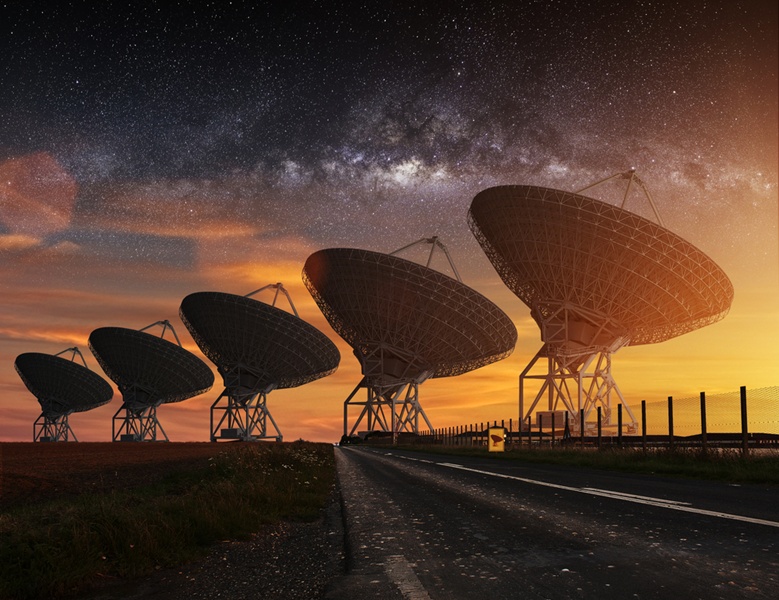Breakthrough Listen and TESS team up for SETI – EarthSky

Image via Breakthrough Listen/Danielle Futselaar/SETI (Search for Extraterrestrial Intelligence) Institute.
In recent decades, missions to planets and moons in our solar system have been alert for signs of microbial life. Astronomers have found thousands of exoplanets, or worlds orbiting distant suns. There’ve been the traditional searches for intelligent radio signals (SETI), now including searches for light signals (optical SETI). Scientists now speak of technosignatures – signs of advanced technologies – as distinct from biosignatures. Late last month, two major programs announced they’re joining forces in the search for intelligent life elsewhere in our galaxy. Breakthrough Listen, part of Breakthrough Initiatives, has announced it will collaborate with NASA’s Transiting Exoplanet Survey Satellite (TESS) mission. Breakthrough Listen has $100 million in funding and is using thousands of hours of dedicated telescope time on state-of-the-art earthly facilities – targeting a million nearby stars and the centers of 100 galaxies – in its search for technosignatures. TESS, meanwhile, uses a novel highly-elliptical orbit around Earth (at its farthest from us, it’s as far as the moon) in its task of seeking – and finding – new exoplanets, including smaller, rocky worlds like Earth.
The new initiative was announced at the International Astronautical Congress (IAC) in Washington, D.C., on October 23, 2019. It’ll be led by TESS Deputy Science Director Sara Seager, S. Pete Worden, Executive Director of Breakthrough Initiatives and Andrew Siemion, leader of the Breakthrough Listen science team.
The collaboration will allow Breakthrough Listen to focus on more specific targets, rocky planets like Earth that may be habitable. Using data from TESS, it is estimated that over 1,000 new “objects of interest” will be added to Breakthrough Listen’s target list. The project will use a wide range of telescopes, including Green Bank, Parkes Telescopes, MeerKAT2, Automated Planet Finder, VERITAS4, NenuFAR, FAST5, Murchison Widefield Array, LOFAR stations in Ireland and Sweden, Jodrell Bank Observatory, e-MERLIN6, Keck Observatory, Sardinia Radio Telescope and Allen Telescope Array7. Worden said:
It’s exciting that the world’s most powerful SETI search, with our partner facilities across the globe, will be collaborating with the TESS team and our most capable planet-hunting machine. We’re looking forward to working together as we try to answer one of the most profound questions about our place in the Universe: Are we alone?
EarthSky 2020 lunar calendars are available! They make great gifts. Order now. Going fast!

Artist’s concept of a Dyson sphere, a hypothetical construction around a star to harness the star’s energy. This is one type of technosignature that could be detected by the new Breakthrough Listen/TESS project. Image via SentientDevelopments.com.
TESS is the planet-hunting successor to the Kepler Space Telescope. Like Kepler, it finds planets by detecting their transits in front of their stars. While Kepler focused on distant stars in certain patches of the sky, TESS looks at stars much closer to us, over about 85% of the sky – 400 times more than Kepler – with a prime focus on rocky worlds similar to Earth in size and mass. TESS was launched in April 2018, and has four wide-field cameras, each monitoring a region of sky 24 degrees across (about the width of your hand held at arm’s length). Light curves – how the brightness of stars changes over time – for 20,000 stars are measured every two minutes, and the brightness of every pixel in the cameras is recorded every 30 minutes.
Over 4,000 exoplanets have been confirmed so far in the past three decades, with many of those coming from Kepler. But TESS is now already quickly adding to that list, and is predicted to find at least 10,000 new exoplanets. Overall, scientists now estimate there are billions of planets in our galaxy alone!

To date, most searches for extraterrestrial intelligence have been limited to using radio telescopes to look for alien radio signals. Breakthrough Listen and the search for technosignatures will greatly expand on that. Image via sdecoret/Shutterstock/Discover.
TESS has a unique advantage in working together with Breakthrough Listen. All the planetary systems it discovers will be edge-on as viewed from Earth. The majority of radio signal leakage on Earth – about 70% – comes from the plane of Earth’s orbit. If an alien civilization had transmitters emitting radio signals in a similar manner, the best chance of detecting them is to view the planetary systems edge-on.
This, of course, has only to do with radio signals. As many scientists now suggest, there are other possibilities for detecting signs of an advanced alien civilization. If such a civilization was much further ahead technologically than us, it might not use radio at all anymore. Both Breakthrough Listen and TESS are capable of finding other kinds of anomalies as well, such as megastructures in orbit around a planet or star, perhaps resembling a Dyson sphere. Boyajian’s Star – aka Tabby’s Star – is a good example of a star exhibiting weird, potentially alien-related behavior, as Siemion noted:
The discovery by the Kepler spacecraft of Boyajian’s Star, an object with wild, and apparently random, variations in its light curve, sparked great excitement and a range of possible explanations, of which megastructures were just one. Follow-up observations have suggested that dust particles in orbit around the star are responsible for the dimming, but studies of anomalies like this are expanding our knowledge of astrophysics, as well as casting a wider net in the search for technosignatures.

Artist’s concept of a super-Earth exoplanet orbiting a nearby star. The TESS mission focuses on searching for rocky planets like this where life might be possible. Image via M. Kornmesser/ESO/MIT News.
For those of us hoping to find evidence of intelligent alien life, this new collaboration is exciting. It will help to better refine search efforts as we learn more about which planetary systems would be the best to focus on instead of the more random kinds of searches done in the past. TESS, and other future planet-hunting telescopes, will be invaluable in determining which exoplanets in our galaxy are the most likely to be habitable, allowing Breakthrough Listen and other SETI-type searches to focus more on such worlds as possible homes for alien intelligence. In Seager’s words:
We are very enthusiastic about joining the Breakthrough Listen SETI search. Out of all the exoplanet endeavors only SETI holds the promise for identifying signs of intelligent life.
Bottom line: Breakthrough Listen and NASA’s exoplanet-hunting mission TESS are teaming up in the search for advanced alien life.






